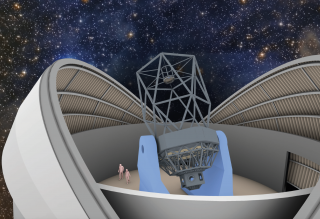Bibcode
Copperwheat, C. M.; Steele, I. A.; Barnsley, R. M.; Bates, S. D.; Bersier, D.; Bode, M. F.; Carter, D.; Clay, N. R.; Collins, C. A.; Darnley, M. J.; Davis, C. J.; Gutierrez, C. M.; Harman, D. J.; James, P. A.; Knapen, J. H.; Kobayashi, S.; Marchant, J. M.; Mazzali, P. A.; Mottram, C. J.; Mundell, C. G.; Newsam, A.; Oscoz, A.; Palle, E.; Piascik, A.; Rebolo, R.; Smith, R. J.
Bibliographical reference
Experimental Astronomy, Volume 39, Issue 1, pp.119-165
Advertised on:
3
2015
Journal
Citations
14
Refereed citations
6
Description
The Liverpool Telescope is one of the world's premier facilities for
time domain astronomy. The time domain landscape is set to radically
change in the coming decade, with synoptic all-sky surveys such as LSST
providing huge numbers of transient detections on a nightly basis;
transient detections across the electromagnetic spectrum from other
major facilities such as SVOM, SKA and CTA; and the era of
`multi-messenger astronomy', wherein astrophysical events are detected
via non-electromagnetic means, such as neutrino or gravitational wave
emission. We describe here our plans for the Liverpool Telescope 2: a
new robotic telescope designed to capitalise on this new era of time
domain astronomy. LT2 will be a 4-metre class facility co-located with
the Liverpool Telescope at the Observatorio del Roque de Los Muchachos
on the Canary island of La Palma. The telescope will be designed for
extremely rapid response: the aim is that the telescope will take data
within 30 seconds of the receipt of a trigger from another facility. The
motivation for this is twofold: firstly it will make it a world-leading
facility for the study of fast fading transients and explosive phenomena
discovered at early times. Secondly, it will enable large-scale
programmes of low-to-intermediate resolution spectral classification of
transients to be performed with great efficiency. In the target-rich
environment of the LSST era, minimising acquisition overheads will be
key to maximising the science gains from any follow-up programme. The
telescope will have a diverse instrument suite which is simultaneously
mounted for automatic changes, but it is envisaged that the primary
instrument will be an intermediate resolution, optical/infrared
spectrograph for scientific exploitation of transients discovered with
the next generation of synoptic survey facilities. In this paper we
outline the core science drivers for the telescope, and the requirements
for the optical and mechanical design.
Related projects

Morphology and dynamics of the Milky Way
This project consists of two parts, each differentiated but both complementary: morphology and dynamics. Detailed study of the morphology of the Milky Way pretends to provide a data base for the stellar distribution in the most remote and heavily obscured regions of our Galaxy, through the development of semiempirical models based on the
Martín
López Corredoira

Spiral Galaxies: Evolution and Consequences
Our small group is well known and respected internationally for our innovative and important work on various aspects of the structure and evolution of nearby spiral galaxies. We primarily use observations at various wavelengths, exploiting synergies that allow us to answer the most pertinent questions relating to what the main properties of
Johan Hendrik
Knapen Koelstra

Exoplanets and Astrobiology
The search for life in the universe has been driven by recent discoveries of planets around other stars (known as exoplanets), becoming one of the most active fields in modern astrophysics. The growing number of new exoplanets discovered in recent years and the recent advance on the study of their atmospheres are not only providing new valuable
Enric
Pallé Bago

IACTEC Large Telescopes: New Robotic Telescope - NRT
The NRT (New Robotic Telescope) is a project to design and build a 4-meter telescope within five years, which from the ORM will operate in a totally autonomous and robotic way. This form of operation will make it the largest robotic telescope in the world.
Carlos Manuel
Gutiérrez de La Cruz